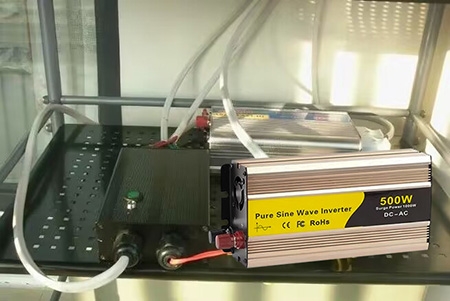Pure sine wave inverters usually have multiple protection functions and are widely used in solar power generation systems, wind power systems, automotive electronics, and other fields. Inverters may need to meet specific performance requirements for different application scenarios. Testing can ensure that pure sine wave inverters meet these requirements and verify whether these protection mechanisms are effective, ensure that the inverter can respond quickly under abnormal conditions, protect the safety of equipment and loads, and provide stable and reliable power support for specific applications.
Instrument equipment preparation
- Digital multimeter: It is used to test the current, voltage and resistance of the pure sine wave inverter, ensure correct wiring and check the basic electrical parameters of the inverter.
- Digital oscilloscope: It is mainly used to check whether the output waveform of the sine wave inverter is a pure sine wave to verify its waveform quality.
- Noise meter: The noise meter measures the noise level during the operation of the inverter and evaluates its quiet performance.
- Insulation resistance tester: The insulation resistance tester measures the insulation resistance of electrical equipment to ensure that the insulation performance of the inverter meets safety standards.
- Pulse generator (optional): It is used to test the performance of the pure sine inverter under high voltage pulses and evaluate its anti-interference ability and stability.
Test steps
Visual inspection
- Check for damage: Before powering the pure sine wave inverter charger, check it for any physical damage, such as cracks, loose connections, or burned components.
- Wiring and connections: Make sure all connections are secure and the input and output terminals are wired correctly. If using a battery pack, verify that the battery connections are secure.

Verify input voltage
- Measure input voltage: Use a multimeter to measure the input voltage of the battery or power supply. Make sure it meets the input voltage requirements of the inverter (e.g., 12V, 24V, 48V).
- Battery condition: If testing with a battery, check the battery's voltage and charge level to make sure it is within the optimal range for the pure sine power inverter.
Output voltage and waveform
- Measure output voltage: After the inverter is powered on, use a multimeter to measure the AC output voltage. It should match the rated output of the inverter (e.g., 120V or 230V, depending on your region).
- Check waveform with an oscilloscope: Connect an oscilloscope to the output of the inverter to check the waveform. A pure sine wave inverter should produce a smooth, continuous sine wave. Any distortion or deviation from a sine wave could indicate a problem with the inverter.
Load test
- Light load test: Start by connecting a light load (e.g., a small lamp or fan) to the inverter. Monitor the inverter's performance to make sure it can power the load without problems.
- Full load test: Gradually increase the load by connecting other devices until you reach the rated capacity of the inverter. Observe how the inverter handles the load, making sure it operates without shutting down or overheating.
- Check overload protection: If possible, slightly exceed the pure sine wave inverter charger's rated capacity to test its overload protection. If the load is too high, the inverter should shut down or issue a warning.
Temperature and fan operation
- Monitor temperature: During the load test, check the temperature of the sine wave inverter to ensure that it does not overheat. Most inverters have built-in cooling fans; make sure these fans are turned on when the inverter gets hot.
- Check the cooling system: Make sure the cooling fans or any other cooling devices are operating properly. The inverter should not get too hot during operation.
Final check and report

- Record results: Record all measurements and observations made during the test. Compare them to the manufacturer's specifications to ensure the inverter is operating as expected.
- Check for noise or unusual behavior: Listen for any unusual noises during operation and check for any unusual behavior, such as flickering lights or erratic performance.
Harmonic distortion test (Optional)
Measure THD: For more advanced testing, you can measure Total Harmonic Distortion (THD) with a power quality analyzer. A pure sine wave inverter should have a low THD, typically less than 3%. High THD may indicate poor output quality.
Verify protection functionality
Check protection functionality: Test the pure sine wave inverter charger's protection features, such as low battery shutdown, overvoltage protection, and short circuit protection. This can usually be done by simulating a fault or abnormal condition to see if the inverter responds appropriately.
Surge test
Test surge capacity: Connect a device that requires a high surge current, such as a refrigerator or motor, and monitor the inverter's ability to handle the surge. The inverter should provide the necessary surge power without tripping or shutting down.
Efficiency test
Measure efficiency: To test the efficiency of a pure sine wave inverter charger, measure the power input (from a battery or power source) and the power output (with an appropriate load). Efficiency is calculated as (Power Output/Power Input) × 100%. Compare the results to the manufacturer's specifications.
